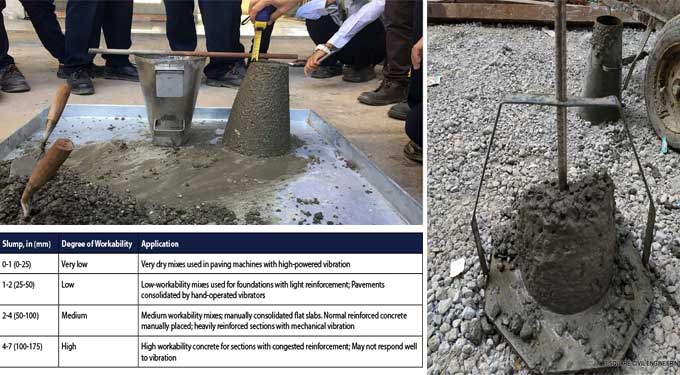
Proportioning Mixture for Concrete with No Slump for Construction
In relation to optimum concrete design, different construction peoples have different expectations and agendas. In addition to stronger construction, the structural engineer wants a strong bond between steel reinforcing bars. It is the architect who is concerned about cosmetic appeal but the owner is interested in bearing capacity because it allows smaller cross-sections of structural elements, resulting in more floor space to be used.
Finishers want a mix that takes a durable, high quality finish quickly and easily, and laborers need something that can be moved, placed, and consolidated efficiently. Concrete with good workability combines many attributes in a balanced manner and produces a long lasting, high quality product.
Define No Slump Concrete
A no slump concrete mix should be consolidated by vibration because of its stiff consistency. Due to its ability to hold its shape once placed, roller compacted concrete and prefabricated concrete construction use it primarily.
To achieve desired workability, strength, and durability, no slump concrete mixes should be thoroughly tested in the lab before being applied in the field or batch plant.
Define Concrete Workability
Concrete workability describes how easily freshly mixed concrete can be mixed, placed, consolidated, and finished without losing its homogeneity. Placement and finishing operations are directly affected by workability, which impacts strength, quality, appearance, and labor costs. Concrete properties can be defined quantitatively rather than qualitatively when testing and documenting them.
Material?s Components for No Slump Concrete
A no slump concrete mix design is similar to a regular concrete mix design, but certain values are calculated differently. Cement fineness modulus, aggregate water absorption, and specific gravity are all required as initial information.
Water Estimation
The amount of water per unit volume of concrete is almost unaffected by cementitious materials below about 360 to 390 Kg per meter cube.
Depending on the maximum aggregate size, particle shape, grade of the aggregate, and quantity of entrained air, a mixture with desired consistency requires a certain amount of water per unit volume. Water demand is increased substantially when Cementitious material is used in greater quantities.
Aggregate Grading
Graded aggregates are crucial to producing a non slump concrete mixture used in the construction of precast units such as drainage and pipes.
Because the products are removed immediately after the concrete is placed and consolidated, forms for these products cannot be reused. Concrete has no external support, so it must be sufficiently cohesive to maintain its shape after removing the form.
Cohesiveness can be achieved by adding sufficient fines to the mixture. Through proper aggregate gradation, this can be accomplished. A laboratory trial and field test should determine the actual water quantity.
Admixtures
Various types of admixtures affect the workability of fresh concrete, either intentionally or unintentionally. Flow able mixes are more achievable with surfactants like super plasticizers that reduce cement aggregate attraction. As a result, it can allow for mixes to be flow able without negatively impacting strength and segregation.
A mix containing air entraining additives for freeze durability can make finishing easier by producing air bubbles within a controlled size, but too much can cause a sticky mix.
Coarse Aggregate Quantity Estimation
While the aggregate quantity is important, it should not hinder the effective consolidation of the concrete mixture with minimal physical and mechanical effort.
Concrete should be mixed with the maximum amount of coarse aggregate per unit volume to achieve maximum strength with the minimum amount of water.
Lab investigations using materials from a project under consideration are the best way to determine the aggregate quantity. It is possible to make adjustments in the field or plant later on.
Uses of Slump Concrete
The non slump concrete is used mostly to make roller compacted concrete structures and to fabricate precast concrete elements, like pipes, pre-stressed members, CMU, and roof tiles. Concrete mix must be very stiff and dry in order to form these elements.
Precast concrete products like pipes, manholes, roof tiles, and pre-stressed members, Slip form pavements, Curbs, concrete structures with roller compacted concrete.
To get more details, watch the following video tutorial.
Video Source: UltraTech Cement
Can you work with no slump concrete?
Slump tests are commonly used to determine concrete's workability. A slump test conducted with hand rod compaction shows poor workability for no-slump concrete. Vibrations are considered to be sufficient to ensure adequate workability.


